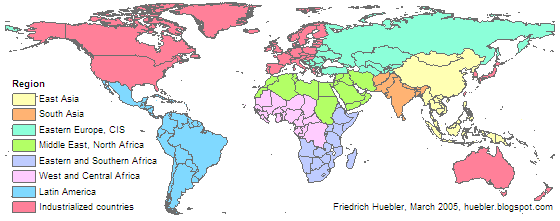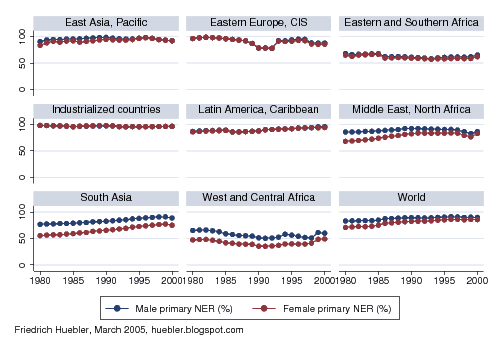- East Asia and the Pacific
- South Asia
- Eastern Europe, Commonwealth of Independent States (CIS)
- Middle East and North Africa
- Eastern and Southern Africa
- West and Central Africa
- Latin America and the Caribbean
- Industrialized countries

Source: UNICEF website, March 2005
The data for the trend analysis is from two sources: (a) UNESCO's Global Education Digest 2004, with data for the years 1998 to 2001; and (b) statistical tables from the website of the UNESCO Institute for Statistics that cover the years 1970 to 1997.
At the global level, the primary school net enrollment ratio (NER) has increased from 78% in 1980 to 88% in 2000. Over the same period, the disparity between boys' and girls' enrollment has decreased from 12% to 4%.
Primary school net enrollment ratio, 1980-2000

Data sources: UNESCO Institute for Statistics (UIS). 2004. Global Education Digest 2004. Montreal: UIS. - World Education Indicators, UNESCO Institute for Statistics, March 2005.
A look at regional trends reveals striking differences. Sub-Saharan Africa has the lowest enrollment rates, with school participation at the same level today as it was in the 1980s. In 2000, the primary school net enrollment ratio for boys and girls combined was 55% in West and Central Africa and 64% in Eastern and Southern Africa. In contrast, the industrialized countries, Latin America, and East Asia are close to achieving the goal of universal primary education for all children.
Girls continue to be disadvantaged in South Asia and in West and Central Africa. Countries in the Middle East and North Africa have made remarkable progress towards gender parity since the 1980s.
Friedrich Huebler, March 2005, Creative Commons License
No comments:
Post a Comment